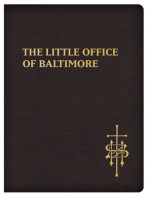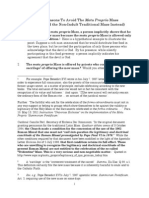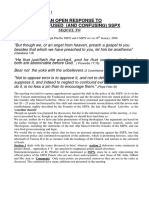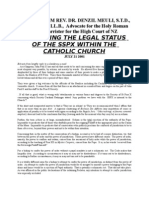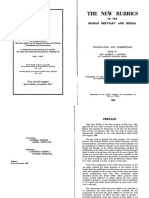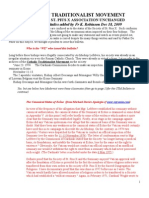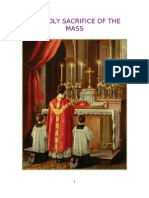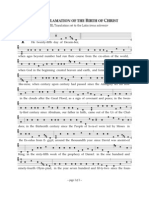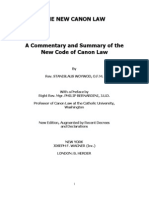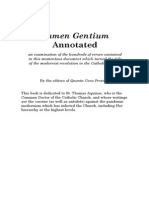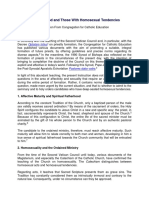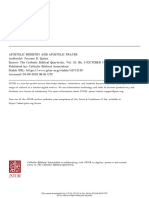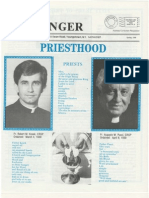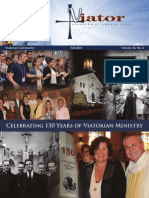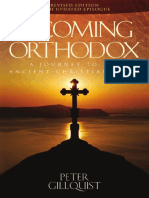Professional Documents
Culture Documents
Comparison of Old and New Catholic Rites of Ordination To The Priesthood
Uploaded by
StThomasAquinasOriginal Title
Copyright
Available Formats
Share this document
Did you find this document useful?
Is this content inappropriate?
Report this DocumentCopyright:
Available Formats
Comparison of Old and New Catholic Rites of Ordination To The Priesthood
Uploaded by
StThomasAquinasCopyright:
Available Formats
Comparison of Old and New Catholic Ordination Rites
Note: * indicates that this part of the rite has been changed. Old Rite 1. Calling the Candidate The Call. The bishop, with his miter on, sits on the faldstool before the middle of the altar. The archdeacon bids the candidates come forward; the notary reads their names: Let those who are to be ordained to the order of the priesthood come forward: N.N., etc. Each one answers: adsum, goes before the altar and kneels, holding the burning candle in his right hand ew Rite 1. Calling the Candidate Before the call, the liturgy of the word takes place. The readings may be taken all or in part from the Mass of the day. The profession of faith is not said. The ordination of a priest begins after the gospel. The bishop, wearing his miter, sits at his chair, The candidate is called by the deacon: Let N. who is to be ordained priest please come forward. The candidate answers: Present, and goes to the bishop, before whom he makes a sign of reverence. 2. The Inquiry Is he worthy? When the candidate is in his place before the bishop, the priest designated by the bishop says: Most Reverend Father, holy mother Church asks you to ordain this man, our brother, for service as priest. The bishop asks: Do you judge him to be worthy? The designated priest answers: After inquiry among the people of Christ and upon recommendation of those concerned with his training, I testify that he has been found worthy. 3. Consent of the People* The bishop makes a statement to choose the candidate. When the candidate is in his place before the bishop, the priest designated by the bishop says: We rely on the help of the Lord God and our Savior Jesus Christ, and we choose this man, our brother, for Priesthood in the presbyteral order. The people reply, Thanks be to God as their consent.
2. The Inquiry Is he worthy? Most Reverend Father, If the ordaining bishop is a cardinal, the archdeacon says: Most Eminent and Reverend Father, Our holy Mother, the Catholic Church, requests that you ordain the deacons here present to the office of the priesthood.
3. Consultation of the People This is a sublime explanation that if any of the faithful know of a reason not to ordain this man, let the knowledge be made public now. The people by silence give consent.
Comparison of the Old and New Ordination Rites
Old Rite 4. Instruction The bishop with solemnity explains that a priest is a man chosen from the people in the Old Testament, as a man chosen by our Lord referring to the twelve disciples, as helpers chosen for Moses, as the twelve apostles chosen by our Lord. The bishop explains how the Church ordains some men bishops, others inferior in rank priests, deacons, and subdeacons. The bishop exhorts the ordinands to live edifying, virtuous lives so they will be a cause of reward, not condemnation to the bishop.
ew Rite 4. Homily* The homily set forth in the rite of ordination is optional and may be in the bishops own words. He only has to talk about the duties of the priest. Of course, this requirement is very vague. One such optional version is as follows: The bishop first speaks to all present. The bishop may say that God has made his entire people a royal priesthood in Christ. . . . Jesus Christ also chose some of His followers to carry out publicly in the Church a priestly ministry in His name on behalf of mankind. The bishop then explains how the apostles were sent into the world. The bishop says that priests are coworkers of the order of bishops. The bishop says, To be ordained to priesthood in the presbyteral order. The bishop refers to Christ as the Teacher, Priest, and Shepherd in His ministry, which is to make His own Body, the Church, grow into the people of God, a holy temple. By consecration he will be made a true priest of the New Testament, to preach the Gospel, sustain Gods people, and celebrate the liturgy, above all, the Lords sacrifice. The bishop exhorts the candidate to be a teacher and make every effort to die to sin and to walk in the new life of Christ. . . . When you baptize, you will bring men and women into the people of God. . . . In the sacrament of penance, you will forgive sins in the name of Christ and the Church. . . . With holy oil, you will relieve and console the sick [no mention of the dying]. . . . You will celebrate the liturgy. . . . [underline added for emphasis]
Comparison of the Old and New Ordination Rites
Old Rite
ew Rite 5. Examination of the Candidate *** Before you proceed to the order of the presbyterate, declare before the people your intention to undertake this priestly office. Are you resolved . . . to discharge . . . the office of priesthood in the presbyteral order. . .? The candidate replies, I am. When one sees the phrase office of the priesthood, one might think that all in this rite is in order, until one looks a little further in this ceremony and sees that nowhere else in the English translation of the Roman Pontifical, not even in the essential Form of the sacrament, is this phrase used. One would think that the conciliar church has an aversion to mentioning the office of the priesthood. The bishop then asks of the candidate, Are you resolved to celebrate the mysteries of Christ faithfully and religiously as the Church has handed them down to us for the glory of God and the sanctification of Christs people? (Does the above refer to the Sacrifice of the Mass? One cannot be sure. If so, how can the ovus Ordo Missae be the mystery of Christ that was handed down to us?) The candidate answers, I am. The bishop: Are you resolved to exercise the ministry of the word worthily and wisely, preaching the gospel and explaining the Catholic faith? (It is not clear if the bishop means only teaching the Catholic faith. If so, one wonders how the novus ordo priests at large have taken this responsibility to heart.) The bishop asks, Are you resolved to consecrate your life to God . . .? Candidate: I am, with the help of God.
Comparison of the Old and New Ordination Rites
Old Rite
ew Rite (I have put no remarks here because the promise is fine and not objectionable.) 6. Promise of Obedience * [The Old Rite has the promise of obedience at the end of the ceremony.] This is simply the promise of the candidate to be obedient to his prelate. Why this is placed here in the ceremony is unclear. 7. Invitation to Prayer Short prayer of the bishop for the one to be ordained. My dear people, let us pray, that the all-powerful Father may pour out the gifts of heaven on this servant of his [sic], whom he has chosen to be a priest. Deacon (except during the Easter season): Let us stand.
Comparison of the Old and New Ordination Rites
Old Rite 5. Prostration and Litany of the Saints The litany is sung or recited while the ordinands lay prostrate.
ew Rite 8. Litany of the Saints Candidate prostrates himself, except during Eastertide. Litany is sung and may be improvised as desired. The bishop says the following prayer for the candidate: Hear us, Lord our God, and pour out upon this servant of yours [sic] the blessing of the Holy Spirit and the grace and power of the priesthood. In your sight we offer this man for ordination: support him with your unfailing love. We ask this through Christ our Lord. Amen. Deacon: Let us stand. (This prayer probably is meant to correspond to the bishops prayer in the Old Rite after the imposition of hands. Cf. Old Rite No. 6) Why is this prayer moved from where the Old Rite said it? It mentions the grace and power of the priesthood. However, why is it placed before the matter of the sacrament, viz., the imposition of the bishops hands, instead of afterwards, which more fittingly emphasizes this important action? Again, one wonders why the power of orders, the sacrificial power of the priesthood, is not mentioned in the rest of the New Rite.
Comparison of the Old and New Ordination Rites
Old Rite 6. Bestowal of the Office The bishop imposes both hands on each ordinand in silence. Holding his right hand extended, the bishop prays a prayer asking heavens blessing on the ordinand. Then the bishop says another prayer for the ordinands. Let us pray, dearly beloved brethren, to God, the Father Almighty, that He may multiply heavenly gifts upon these His servants whom He has chosen for the office of the priesthood. May they by His help accomplish what they undertake at His gracious call. Through Christ our Lord. R. Amen. 7. Prayer of Consecration Here the responses before a preface are said and the bishop says a preface that is solemn and includes the essential form of the ordination. The traditional preface mentions that teachers not fellow-workers were given to the Son to spread the faith. See essential form given by Pope Pius XII as follows in English and in Latin: We beseech Thee, Almighty Father, invest Thy servant with the dignity of the priesthood. Do Thou renew in his heart the spirit of holiness, that he may hold the office next to ours in importance (that is, second in rank after the bishop), which he has received from Thee, O Lord, and by the example of his life, point out a norm of conduct.
ew Rite 9. Laying on of Hands The bishop lays his hands on the candidates head in silence. Note: there is no prayer here for the ordinand. In the Old Rite, the office of the priesthood is specifically mentioned.
10. Prayer of Consecration***** Looser translation of the old preface. When referring to Aaron this rite excludes the word priestly when speaking of Aarons power. The addition of the words/description fellow workers is disturbing, again putting priests and bishops on equal footing.
Almighty Father, grant to this servant of yours the dignity of the priesthood. Renew within him the Spirit of holiness. As a co-worker with the order of bishops may he be faithful to the ministry that he receives from you, Lord God, and be to others a model of right conduct.
Comparison of the Old and New Ordination Rites
Old Rite Da quaesumus, omnipotens Pater, in hunc famulum Tuum Presbyterii dignitatem; innova in visceribus ejus spiritum sanctitatis ut acceptum a Te, Deus, secundi meriti munus obtineat censuramque morum exemplo suae conversationis insinuet. [underline added for emphasis]
ew Rite The New Rite in English adds, May he be faithful to the ministry, which is not found in the Old Rite. that he receives from You, Lord God is put right after May he be faithful . . . ministry so what he receives seems to refer to ministry. This ambiguity makes it seem that the candidate has received the ministry and not the priesthood itself. The word ministry is a general term and does not refer to a single office. The New Rite in English clearly makes the priest on equal footing as the bishop, calling them co-workers. After the essential form the new rite (at least in English) adds a part that sounds so Protestant as is drastically different from the old rite. The words are rather troubling. The new rite states that the new priest be faithful in working with the order of bishops . . . so that the words of the Gospel may reach the ends of the earth and the family of nations, made one in Christ, may become Gods one, holy people. This is ambiguous. Does it mean that the nations convert in order to become a family united in Christ and then become one Church? Or does it mean (in modernist ecumenical language) that the nations are intrinsically united and a family already and that this family may become Gods people, merely Christian but not necessarily Catholic. 11. Investiture with Stole and Chasuble* An assistant arranges the stole on the newly ordained. No prayer is said.
The Old Rite clearly ranks the priest after the bishop and states clearly that the ordinand has received an office/post. After the essential form the old rite continues and refers to the new priest being a pattern of justice and his having to render an account to God and if he is faithful he will receive an eternal reward.
8. Investiture with the Priestly Vestment The bishop himself arranges the stole on the ordinand. Receive the yoke of the Lord, for His yoke is sweet and His burden light.
Comparison of the Old and New Ordination Rites
Old Rite The bishop himself vests the candidates with the chasuble. Receive the priestly vestment, by which charity is signified; for God is powerful to increase unto thee charity and perfection of work. [emphasis added] And then the bishop prays a long prayer which states explicitly that the bishop has conferred the honor of the Priesthood and also states that the new ordinands may change by a holy benediction bread and wine into the body and blood of Thy Son O God, Author of all holiness, from whom comes true consecration and the fullness of benediction, do Thou, O Lord, pour out Thy gracious blessing upon these Thy servants, upon whom we confer the honor of the priesthood. May they, by gravity of demeanor and strictness of life, prove themselves to be elders, trained according to the principles which Paul set forth to Titus and Timothy. May they keep Thy law before their minds day and night, believe what they read, teach what they believe, and practice what they teach. May they show forth in their persons justice, constancy, mercy, fortitude, and all other virtues, be leaders by their example, inspire strength by exhortation, and preserve the gift of their ministry pure and undefiled; may they change by a holy benediction bread and wine into the body and blood of Thy Son for the worship of Thy people. And having kept their conscience pure and true their faith in never failing charity, may they rise on the day of God's just and final judgment, full of the Holy Spirit, to perfect manhood, in the full measure of the age of Christ. Through the same etc. Jesus Christ, Thy Son, our Lord, etc. R. Amen.
ew Rite Again, an assistant arranges the chasuble on the newly ordained. No prayer is said. It is interesting to note that the reference to the priesthood and transubstantiation has been removed.
Comparison of the Old and New Ordination Rites
Old Rite 9. The Anointing The bishop intones the Veni Creator. While the Veni Creator is being sung the bishop anoints the hands of the ordinand in a very symbolic way for the thumbs and index fingers are anointed first then the whole palm. [For the thumbs and index fingers are what will hold the consecrated Host] The bishop says the following prayer while anointing: Vouchsafe, O Lord, to consecrate and sanctify these hands by this unction and our + blessing.
ew Rite 12. The Anointing ***** It is important to note that the Veni Creator Spiritus or Ps. 110 may be sung during the vesting and anointing. This is totally optional.
The bishop anoints the palms of the hands in no significant order. The bishop says the following prayer while anointing the palms: The Father anointed Our Lord Jesus Christ through the power of the Holy Spirit. May Jesus preserve you to sanctify the Christian people and to offer sacrifice to God. He continues, that whatsoever they [these hands] shall bless may There is no mention in the New Rite, of the thumbs, index fingers, be blessed and whatsoever they shall consecrate be consecrated or the fingers at all, being anointed. This is very significant because it suggests that these digits are not important. Are not and sanctified in the name of our Lord Jesus Christ. these fingers supposed to be ready to hold the Sacred Host? Contrast the vague prayer of the New Rite to the explicit prayer to [It is interesting to note the changes in the anointing prayer. The confer a power to bless and consecrate (which would include the Old Rite is explicit and says plainly that the ordinands hands are power to consecrate the Blessed Sacrament) being now anointed. The New Rite doesnt say that the ordinands palms are being now anointed. In fact, if one were not watching and only listening, he would never know that the bishop was actually anointing the ordinands palms at the moment when the bishop refers to God the Father having anointed his Son. Furthermore, the wording of the rest of the prayer is so general it could easily refer to a layman. May Jesus preserve you to sanctify the Christian people, [everyone should help sanctify others] and offer sacrifice to God. [It doesnt mention the Sacrifice of the Mass. What sacrifice does it mean? Arent all Catholics supposed to offer up sacrifices to God?]
Comparison of the Old and New Ordination Rites
10
Old Rite 10. Bestowal of the Power to Offer the Holy Sacrifice of the Mass The bishop presents each ordinand with a chalice containing wine and water and a paten with a host on it, while the ordinand is touching the paten with the index finger and the chalice with the middle finger. The bishop explicitly states, Receive the power to offer sacrifice to God and to celebrate Mass for the living as well as for the dead. In the name of the Lord. The bishop washes his hands and continues saying the Mass.
ew Rite **** This is omitted. **** 13. Presentation of the Gifts Contrast the Old Rite and the New Rite, where in typical modernist style, the deacon receives the offertory gifts of bread and wine from the people and prepares the gifts for the new priests. The deacon hands them to the bishop, who gives them to the new priests, saying: Accept from the holy people of God the gifts to be offered to him. Know what you are doing and imitate the mystery you celebrate: model your life on the mystery of the Lords Cross. The modern rite does not explicitly manifest that the new priest has the power to offer the sacrifice of the Mass. The words above indicate almost a fear of referring to the Unbloody Sacrifice of the Mass. 14. The Kiss of Peace * [This takes place at a different place in the ew Rite than in the Old Rite.] Lastly, the bishop stands and gives the kiss of peace to the new priest, saying: Peace be with you. The priest responds: And also with you. If circumstances permit, the priests present also give the kiss of peace to the newly ordained. Meanwhile, the antiphon You are my friends, says the Lord, if you do what I command you and Psalm 100 may be sung, repeating the antiphon every two verses. The psalm is interrupted when the priests present have received the kiss of peace.
11. After the Offertory The bishop puts on his miter and takes his seat and receives a candle from each ordinand. And then the new ordinands continue to say the Mass with the bishop. 12. Continuation of the Mass and the Communion of the Ordained This takes place and the ordained receive under one species only. After receiving Holy Communion, the bishop finishes the ablutions, then intones the responsories.
Comparison of the Old and New Ordination Rites
11
Old Rite I will not now call you servants but my friends; for you have known all things whatsoever I have wrought in the midst of you. Alleluia.
ew Rite Any other appropriate song may be sung, or No longer do I call you servants, but my friends, because you know all that I have done among you.
Receive in you the Holy Spirit, the Paraclete; He it is whom the Father will send you. Alleluia. You are my friends if you do the things that I command you. Receive in you the Holy Spirit, the Paraclete. Glory be to the Father, and to the Son, and to the Holy Ghost. He it is whom the Father will send you. Alleluia
Receive the Holy Spirit as an Advocate among you: it is he whom the Father will send you. You are my friends if you do the things I command you. Receive the Holy Spirit as an Advocate among you. Glory be to the Father . . . It is he whom the Father will send you. [After the Kiss of Peace, the liturgy of the eucharist takes place and apparently the ovus Ordo Missae is concluded with no other special ceremonies occurring.]
[It is interesting to note that the responsories of the Old Rite are put after the distribution of Holy Communion, but in the New Rite they are put before the actual concelebration of the Masss consecration.] 13. Recital of the Apostles Creed **** Omitted **** The new ordinands now recite the Apostles Creed as a profession of faith.
Comparison of the Old and New Ordination Rites
12
Old Rite ew Rite 14. Bestowal of the Power to Forgive Sins **** Omitted **** The old rite solemnly declares the power that was already given to the priest in the moment of his ordination. The newly ordained kneel before the bishop. The bishop lays his [It is interesting to note that this is omitted, which makes the responsories above seem ludicrous, because the Father is to send hands on each ordinand and says: the Holy Spirit, but yet there is never any indication that the Holy Receive the Holy Ghost; whose sins thou shalt forgive, Ghost has actually come to the ordinand, whereas in the Old Rite, there is the prayer invoking the Holy Ghost in actuality to come. they are forgiven them; and whose sins thou shalt This is an appalling omission of the declaring of such an retain, they are retained. important function of the priest.] 15. The Unfolding of the Chasuble **** Omitted **** The bishop unfolds the ordinands chasuble. Then the bishop unfolds the back part of the chasuble, saying: May the Lord clothe thee with the robe of innocence. This is symbolic of the full powers now formally bestowed.
Comparison of the Old and New Ordination Rites
13
Old Rite 16. The Solemn Promise of Obedience In the Old Rite it seems more fitting that the new priest can now promise obedience as a priest. Now the bishop takes both hands of the ordained into his own and asks for the promise of obedience. If he is the Ordinary of the ordained, he says: Dost thou promise me and my successors reverence and obedience? If the bishop is not the Ordinary of the ordained, he says: To secular priests: Dost thou promise to the Bishop, thy Ordinary ? To religious priests: Dost thou promise to the Bishop (or Prelate) who will be thy Ordinary for the time being, reverence and obedience? The priest answers: I promise.
ew Rite These promises were made earlier in the New Rite (see No. 6), even before the form of ordination.
* This was done earlier in the New Rite 17. The Kiss of Peace The kiss of peace is a small ceremonial gesture, which shows the fatherly affection bishop has for his new priestly son, who has just promised to be obedient. This seems more fittingly placed here than where it is placed in the showy modernist New Rite Novus Ordo Mass. Then the bishop, still holding the newly ordained priest's hands within his own, kisses him on the right cheek, saying: The peace of the Lord be always with thee. The priest answers: Amen.
Comparison of the Old and New Ordination Rites
14
Old Rite 18. The Instruction The bishop solemnly exhorts the new priest to take care in performing his awesome responsibility of offering the Mass. [It is fitting that the father figure of the bishop should now exhort his son, the new priest.] The bishop, having received the crosier, now addresses to the newly ordained priests the following exhortation: Dearly beloved sons, since the office which you will perform is beset with considerable danger, I admonish you to learn carefully from other experienced priests the order of the whole Mass, the consecration and the breaking of the host, and the communion, before you begin to celebrate Mass.
ew Rite **** Omitted ****
Comparison of the Old and New Ordination Rites
15
Old Rite 19. The Solemn Blessing The bishop blesses the new priest as follows: The bishop rises and blesses the priests kneeling before him: May the blessing of the almighty God, the + Father, the + Son, and the Holy + Ghost, descend upon you, that you may be blessed in the priestly order, and offer up the sacrifice of propitiation for the sins and offenses of the people to almighty God, to whom be honor and glory forever and ever. R. Amen. [It is interesting to note that this blessing explicitly states the sacrificial power of the priest and that the ew Rite omits it and never explicitly states this power.] The bishop lays aside miter and crosier and continues the Mass prayers (the Communion verse and Post Communion verse) together with the newly ordained.
ew Rite **** Omitted **** This is a surprising and unexplainable omission in the New Rite. It is important to point out that the ew Rite of ordination takes place in a sacrilegious ovus Ordo Mass!!!
Comparison of the Old and New Ordination Rites
16
Old Rite 20. The Final Admonition (After the Last Blessing) With miter on and crosier in hand, the bishop seats himself and addresses all the ordained kneeling before him. If all orders have been conferred, the following admonition is read as it stands; if not, reference to the orders not received is left out. Dearly beloved sons, carefully consider the order which you have received today and the burden which has been laid upon your shoulders. Endeavor to live holy lives devoted to religion and to be pleasing to the almighty God, that you may obtain His grace. May He in His mercy deign to bestow it upon you. The bishop having put aside the crosier and miter goes to the gospel side of the altar and, together with the newly ordained priest, begins the Last Gospel.
ew Rite ****Omitted*****
Comparison of the Old and New Ordination Rites
17
You might also like
- Ceremonies of the Modern Roman Rite: The Eucharist and the Liturgy of the HoursFrom EverandCeremonies of the Modern Roman Rite: The Eucharist and the Liturgy of the HoursRating: 4.5 out of 5 stars4.5/5 (12)
- Comparison of Old and New Consecration RitesDocument49 pagesComparison of Old and New Consecration RitesStThomasAquinas100% (6)
- The Resurrection of the Roman Catholic Church: A Guide to the Traditional Catholic CommunityFrom EverandThe Resurrection of the Roman Catholic Church: A Guide to the Traditional Catholic CommunityNo ratings yet
- Ordination ValidityDocument12 pagesOrdination ValidityQuo Primum100% (1)
- The Little Office of Baltimore: Traditional Catholic Daily PrayerFrom EverandThe Little Office of Baltimore: Traditional Catholic Daily PrayerNo ratings yet
- SSPX Seminary Mass CourseDocument77 pagesSSPX Seminary Mass CourseQuo Primum78% (9)
- Catholicism and Fundamentalism: The Attack on 'Romanism' by 'Bible Christians'From EverandCatholicism and Fundamentalism: The Attack on 'Romanism' by 'Bible Christians'Rating: 4 out of 5 stars4/5 (75)
- Why We Are Traditional CatholicsDocument6 pagesWhy We Are Traditional CatholicsQuo Primum100% (1)
- Clergy EtiquetteDocument26 pagesClergy EtiquetteQuo Primum100% (1)
- FSSPX Supplied JurisdictionDocument9 pagesFSSPX Supplied JurisdictionQuo Primum100% (2)
- Vatican Admits Society of Saint Pius X Masses Fulfill Sunday ObligationDocument4 pagesVatican Admits Society of Saint Pius X Masses Fulfill Sunday ObligationQuo Primum100% (1)
- 20 Reasons Not To Attend The Motu Proprio MassDocument5 pages20 Reasons Not To Attend The Motu Proprio MassStThomasAquinas60% (5)
- Open Response To The Confused SSPXDocument33 pagesOpen Response To The Confused SSPXgilbertnunesNo ratings yet
- I Accuse The Council!Document120 pagesI Accuse The Council!Quo Primum86% (7)
- What Is Wrong With Latin Masses ApprovedDocument2 pagesWhat Is Wrong With Latin Masses ApprovedQuo PrimumNo ratings yet
- A List of DontsDocument5 pagesA List of DontsQuo PrimumNo ratings yet
- Latin Mass Options 4UZFGaQXzHnDocument6 pagesLatin Mass Options 4UZFGaQXzHnQuo PrimumNo ratings yet
- Meuli Letter Re SSPXDocument5 pagesMeuli Letter Re SSPXQuo Primum100% (2)
- Rubrics of The Roman Brievary and Missal 1962Document111 pagesRubrics of The Roman Brievary and Missal 1962Alan Amato100% (3)
- Most Asked Questions SSPXDocument32 pagesMost Asked Questions SSPXQuo Primum100% (2)
- This Is The Mass (1960) SheenDocument130 pagesThis Is The Mass (1960) SheenStephenConrad100% (18)
- Catholic Traditionalist Movement ReplyDocument19 pagesCatholic Traditionalist Movement ReplyQuo Primum100% (2)
- Response To SSPX Letter Fr. SelignyDocument14 pagesResponse To SSPX Letter Fr. SelignyQuo Primum100% (3)
- The Tridentine MassDocument53 pagesThe Tridentine MassMiguel Vas100% (7)
- Ministry of AcolyteDocument2 pagesMinistry of AcolyteJohn Angelo Martin100% (3)
- The New Rite of OrdinationDocument8 pagesThe New Rite of Ordinationvaticancatholic.com100% (1)
- The Problem With The Liturgical ReformDocument118 pagesThe Problem With The Liturgical ReformQuo Primum78% (9)
- The Great Sacrilege - Fr. Wathon PDFDocument254 pagesThe Great Sacrilege - Fr. Wathon PDFvargus1267% (3)
- On ConfirmationDocument36 pagesOn ConfirmationQuo Primum100% (1)
- The Early Roman Canon Missae (Ratcliff e Couratin)Document14 pagesThe Early Roman Canon Missae (Ratcliff e Couratin)oratefratres100% (2)
- Pontificale Romanum Vatican IIDocument267 pagesPontificale Romanum Vatican IIErdődi Endre Sámuel100% (2)
- Short History of The Roman Mass by Michael DaviesDocument28 pagesShort History of The Roman Mass by Michael Daviesgustavochateaubriand100% (1)
- Archbishop Schneider Interview: NCW Is A HereseyDocument18 pagesArchbishop Schneider Interview: NCW Is A HereseyTimRohrNo ratings yet
- The Reform of The Roman Liturgy by Msgr. Klaus GamberDocument116 pagesThe Reform of The Roman Liturgy by Msgr. Klaus GamberHermit WithoutA permit100% (16)
- The Arguments Against The Novus Ordo PicturesDocument34 pagesThe Arguments Against The Novus Ordo Picturespsamiaoue75% (4)
- Michael Davies Liturgical ShipwreckDocument21 pagesMichael Davies Liturgical ShipwreckMarcus Vinicius Diniz100% (4)
- Why Not Wait For The Traditional Bishops To Elect A Pope.Document12 pagesWhy Not Wait For The Traditional Bishops To Elect A Pope.David Bawden100% (2)
- To The Members of The Society of Jesus in Portugal: On Perfect ObedienceDocument6 pagesTo The Members of The Society of Jesus in Portugal: On Perfect ObedienceQuo PrimumNo ratings yet
- Understanding When To Kneel Sit and Stand at The Traditional Latin MassDocument21 pagesUnderstanding When To Kneel Sit and Stand at The Traditional Latin MassCarlos Antonio P. Palad80% (5)
- Liturgical MattersDocument1,197 pagesLiturgical MattersPeter Emanuel Bútora100% (4)
- Supressed Interview With Archbishop LefebvreDocument9 pagesSupressed Interview With Archbishop LefebvreQuo Primum100% (8)
- SSPX SA HistoryDocument324 pagesSSPX SA HistoryLukeNo ratings yet
- Scruples PDFDocument20 pagesScruples PDFQuo Primum100% (3)
- The Dubiety of OrdinationDocument36 pagesThe Dubiety of OrdinationPistrina100% (1)
- Architects of Confusion: The Unmasking of The Plot Against The Church's Foundational Doctrine On SalvationDocument23 pagesArchitects of Confusion: The Unmasking of The Plot Against The Church's Foundational Doctrine On SalvationExtraEcclesiamNullaSalusNo ratings yet
- The SSPX and The CouncilDocument122 pagesThe SSPX and The CouncilMoyraDoorlyNo ratings yet
- De Castro MayerDocument20 pagesDe Castro MayerQuo PrimumNo ratings yet
- Liturgical Changes From 1964, Roman Rite of MassDocument4 pagesLiturgical Changes From 1964, Roman Rite of MassChurch Music Association of America100% (2)
- Book Papal Plan 20121223-1Document200 pagesBook Papal Plan 20121223-1Quo Primum100% (1)
- Boylan, Difficulties in Mental PrayerDocument141 pagesBoylan, Difficulties in Mental Prayerfrancisco100% (4)
- LiturgyDocument33 pagesLiturgyMiguel AngeloNo ratings yet
- Christmas Proclamation (Traditional Melody, 2011 ICEL English Text)Document2 pagesChristmas Proclamation (Traditional Melody, 2011 ICEL English Text)AristotleAEsguerra100% (11)
- 1983 Code of Canon Law StructureDocument6 pages1983 Code of Canon Law StructureJason TiongcoNo ratings yet
- Cana Is Forever: Counsels For Before and After Marriage by Fr. Charles Hugo DoyleDocument135 pagesCana Is Forever: Counsels For Before and After Marriage by Fr. Charles Hugo DoyleExtraEcclesiamNullaSalus100% (1)
- Arnaldo Vidigal Xavier Da Silveira Replies To FR Gleize On Heretical PopeDocument12 pagesArnaldo Vidigal Xavier Da Silveira Replies To FR Gleize On Heretical PopeBrianBoruIVNo ratings yet
- Solemn Blessing of Epiphany Water in The Traditional Roman RiteDocument24 pagesSolemn Blessing of Epiphany Water in The Traditional Roman RiteA Catholic Life Blog100% (3)
- Commentary of The New Code of Canon LawDocument212 pagesCommentary of The New Code of Canon LawJon100% (8)
- RITE OF ORDINATION TO THE PRIESTHOOD (With Commentator)Document42 pagesRITE OF ORDINATION TO THE PRIESTHOOD (With Commentator)Jose Rizal100% (1)
- Comparison of Old and New Catholic Ordination RitesDocument17 pagesComparison of Old and New Catholic Ordination RitesJose ArizagaNo ratings yet
- Ordinal 2 0Document24 pagesOrdinal 2 0TheLivingChurchdocsNo ratings yet
- Revolution Is Always WrongDocument3 pagesRevolution Is Always WrongStThomasAquinas100% (1)
- 20 Reasons Not To Attend The Motu Proprio MassDocument5 pages20 Reasons Not To Attend The Motu Proprio MassStThomasAquinas60% (5)
- Lumen Gentium AnnotatedDocument364 pagesLumen Gentium AnnotatedStThomasAquinas43% (7)
- Social Kingship of Our LordDocument26 pagesSocial Kingship of Our LordStThomasAquinasNo ratings yet
- Doubtfulness of New Catholic Ordination RiteDocument17 pagesDoubtfulness of New Catholic Ordination RiteStThomasAquinas100% (4)
- Catholic Word BookDocument76 pagesCatholic Word BookMichael Pagaduan100% (3)
- 2 Timothy 11 OutlineDocument17 pages2 Timothy 11 OutlineSperanta BurlacuNo ratings yet
- Brethren Distinctive SDocument9 pagesBrethren Distinctive SDaisilySamuelNo ratings yet
- On Priesthood and Those With Homosexual TendenciesDocument5 pagesOn Priesthood and Those With Homosexual TendenciesJohn Raven BernarteNo ratings yet
- Ben Williams InterviewDocument21 pagesBen Williams Interviewapi-349365194No ratings yet
- Southern Africa Union Theology of Ordination and Women ReportDocument20 pagesSouthern Africa Union Theology of Ordination and Women ReportJared Wright (Spectrum Magazine)No ratings yet
- Apostolic Ministry and Apostolic PrayerDocument14 pagesApostolic Ministry and Apostolic PrayerTrung ThanNo ratings yet
- Cle Reviewer For Periodical TestDocument6 pagesCle Reviewer For Periodical TestReinhard Gyram GonzalesNo ratings yet
- Key Observations: Role of The Church in Contemporary SocietyDocument3 pagesKey Observations: Role of The Church in Contemporary SocietyJilebi JangryNo ratings yet
- Zagano JES Corrected23APR10Document14 pagesZagano JES Corrected23APR10Raul Oscar AmadoNo ratings yet
- Associate Priest Job DescriptionDocument8 pagesAssociate Priest Job DescriptionsttomsherwoodparkNo ratings yet
- The Seven Sacraments 1Document17 pagesThe Seven Sacraments 1Lance RapaNo ratings yet
- Diaconate Ordination HomilyDocument2 pagesDiaconate Ordination HomilyLloyd MendozaNo ratings yet
- On The Ordination of Women in The Catholic Church (Full Transcript)Document2 pagesOn The Ordination of Women in The Catholic Church (Full Transcript)Diane Therese HuldongNo ratings yet
- Fifty Years of Priesthood of Fr. PucciDocument2 pagesFifty Years of Priesthood of Fr. PucciBarnabite PublicationsNo ratings yet
- Religion Finals: SacramentDocument17 pagesReligion Finals: SacramentMYKRISTIE JHO MENDEZNo ratings yet
- A Great Battle in The Ecclesiastical Heavens PDFDocument53 pagesA Great Battle in The Ecclesiastical Heavens PDFefestioNo ratings yet
- Viator 2015 FallDocument16 pagesViator 2015 FallSersoSanViatorNo ratings yet
- Celibacy in Crisis - A Secret World Revisited (PDFDrive)Document368 pagesCelibacy in Crisis - A Secret World Revisited (PDFDrive)ALAQMARRAJ100% (2)
- Pontificale Romanum Vatican IIDocument267 pagesPontificale Romanum Vatican IIErdődi Endre Sámuel100% (2)
- Primacy PDFDocument25 pagesPrimacy PDFJeremiah Clemente dC TorresNo ratings yet
- The Sacrament of Ordination (The Institution of Holy Orders)Document13 pagesThe Sacrament of Ordination (The Institution of Holy Orders)Stephanie Angel OmpadNo ratings yet
- Fream Donald Maxine 1958 JamaicaDocument31 pagesFream Donald Maxine 1958 Jamaicathe missions network100% (1)
- A Marriage Divorce Remarriage Paper - AMiADocument41 pagesA Marriage Divorce Remarriage Paper - AMiAundeliverableau3870No ratings yet
- Richard Sokupa 1Document6 pagesRichard Sokupa 1Petrosfiy MuleyaNo ratings yet
- Investigating Christian Theology II Instructor GuideDocument288 pagesInvestigating Christian Theology II Instructor GuideApril Showers100% (2)
- Sacraments of Service and CommitmentDocument27 pagesSacraments of Service and CommitmentAilyn Fe GolosinoNo ratings yet
- Orthodox Christianity in The 21st CenturyDocument48 pagesOrthodox Christianity in The 21st CenturyΑντώνης ΧρυσόπουλοςNo ratings yet
- Becoming OrthodoxDocument204 pagesBecoming OrthodoxBrendan-Michael Hammacher100% (5)
- Now and Not Yet: Pressing in When You’re Waiting, Wanting, and Restless for MoreFrom EverandNow and Not Yet: Pressing in When You’re Waiting, Wanting, and Restless for MoreRating: 5 out of 5 stars5/5 (4)
- Out of the Dark: My Journey Through the Shadows to Find God's JoyFrom EverandOut of the Dark: My Journey Through the Shadows to Find God's JoyRating: 4.5 out of 5 stars4.5/5 (10)
- Out of the Dark: My Journey Through the Shadows to Find God's JoyFrom EverandOut of the Dark: My Journey Through the Shadows to Find God's JoyRating: 5 out of 5 stars5/5 (5)
- The Garden Within: Where the War with Your Emotions Ends and Your Most Powerful Life BeginsFrom EverandThe Garden Within: Where the War with Your Emotions Ends and Your Most Powerful Life BeginsNo ratings yet
- Tired of Being Tired: Receive God's Realistic Rest for Your Soul-Deep ExhaustionFrom EverandTired of Being Tired: Receive God's Realistic Rest for Your Soul-Deep ExhaustionRating: 5 out of 5 stars5/5 (1)
- Crazy Love, Revised and Updated: Overwhelmed by a Relentless GodFrom EverandCrazy Love, Revised and Updated: Overwhelmed by a Relentless GodRating: 4.5 out of 5 stars4.5/5 (1000)
- Bait of Satan: Living Free from the Deadly Trap of OffenseFrom EverandBait of Satan: Living Free from the Deadly Trap of OffenseRating: 5 out of 5 stars5/5 (307)
- The Dangers of a Shallow Faith: Awakening From Spiritual LethargyFrom EverandThe Dangers of a Shallow Faith: Awakening From Spiritual LethargyRating: 5 out of 5 stars5/5 (134)
- The Freedom of Self-Forgetfulness: The Path to True Christian JoyFrom EverandThe Freedom of Self-Forgetfulness: The Path to True Christian JoyRating: 5 out of 5 stars5/5 (188)
- The Deconstruction of Christianity: What It Is, Why It’s Destructive, and How to RespondFrom EverandThe Deconstruction of Christianity: What It Is, Why It’s Destructive, and How to RespondRating: 4.5 out of 5 stars4.5/5 (26)
- Holy Hygge: Creating a Place for People to Gather and the Gospel to GrowFrom EverandHoly Hygge: Creating a Place for People to Gather and the Gospel to GrowRating: 4.5 out of 5 stars4.5/5 (100)
- The Blood of the Lamb: The Conquering WeaponFrom EverandThe Blood of the Lamb: The Conquering WeaponRating: 5 out of 5 stars5/5 (234)
- How to Walk into a Room: The Art of Knowing When to Stay and When to Walk AwayFrom EverandHow to Walk into a Room: The Art of Knowing When to Stay and When to Walk AwayRating: 4.5 out of 5 stars4.5/5 (4)
- Just Do Something: A Liberating Approach to Finding God's WillFrom EverandJust Do Something: A Liberating Approach to Finding God's WillRating: 5 out of 5 stars5/5 (95)
- Jesus and the Powers: Christian Political Witness in an Age of Totalitarian Terror and Dysfunctional DemocraciesFrom EverandJesus and the Powers: Christian Political Witness in an Age of Totalitarian Terror and Dysfunctional DemocraciesRating: 5 out of 5 stars5/5 (4)
- For Women Only, Revised and Updated Edition: What You Need to Know About the Inner Lives of MenFrom EverandFor Women Only, Revised and Updated Edition: What You Need to Know About the Inner Lives of MenRating: 4.5 out of 5 stars4.5/5 (267)
- The Well-Watered Woman: Rooted in Truth, Growing in Grace, Flourishing in FaithFrom EverandThe Well-Watered Woman: Rooted in Truth, Growing in Grace, Flourishing in FaithRating: 4.5 out of 5 stars4.5/5 (63)
- Understanding the Purpose and Power of Prayer: How to Call Heaven to EarthFrom EverandUnderstanding the Purpose and Power of Prayer: How to Call Heaven to EarthRating: 5 out of 5 stars5/5 (77)
- The False White Gospel: Rejecting Christian Nationalism, Reclaiming True Faith, and Refounding DemocracyFrom EverandThe False White Gospel: Rejecting Christian Nationalism, Reclaiming True Faith, and Refounding DemocracyRating: 3 out of 5 stars3/5 (2)




